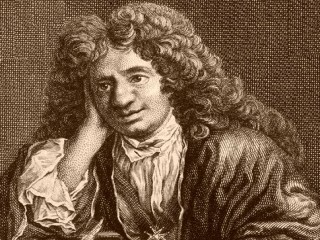
Francois Couperin (En.) biography
Date of birth : 1668-11-10
Date of death : 1773-09-12
Birthplace : Paris, France
Nationality : French
Category : Famous Figures
Last modified : 2011-05-04
Credited as : Composer, harpsichordist, King Louis XIV
François Couperin, called Couperin leGrand, was a French composer, organist, and harpsichordist. His harpsichord and organ works are the touchstones of the 18th-century elegant style.
François Couperin was born on Nov. 10, 1668, in Paris. The Couperin dynasty was the most famous musical family in France during the 17th and 18th centuries. The first Couperin came to Paris from the region of Brie and became organist for the church of St-Gervais; his brothers soon followed. Couperin's father, Charles, succeeded his brother Louis on the latter's death in 1661. Charles died in 1679, and although François was only 11 years old he was named as Charles's successor at St-Gervais. The post was held open for François both on legal grounds and in the light of his extraordinary talent until he reached the age of 18.
In 1692 Couperin produced his first publications, pieces composed in the Italian manner. While retaining his post at St-Gervais, he entered the service of King Louis XIV in 1693 as one of the organists of the King's chapel at Versailles. Couperin prospered at court, being appointed master of music for the royal children in 1694 and ennobled in 1696.
Couperin composed much church music for use at Versailles. His keyboard and chamber music circulated in aristocratic circles. In 1713 the King granted Couperin the privilege of publishing his own music. He first issued a series of harpsichord suites (which he called ordres) written over the preceding 2 decades. In 1714 he published the three surviving sets from a projected group of nine Leçons des Tenebres. L'Art de toucher le clavecin, his major theoretical work, appeared in 1716. The second order of harpsichord pieces came out in 1717, and the following year Couperin succeeded to the post of ordinaire de la musique to the King. Encouraged by the success of his publications, Couperin brought out sets and suites of earlier compositions in rapid order, and in 1730 his fourth ordre of harpsichord pieces was put together with the assistance of his family. He died on Sept. 12, 1733.
The bulk of Couperin's published work disappeared shortly after his death. Since his only son is presumed to have died in infancy, the post of organist at St-Gervais passed to a nephew. The position remained in the family until the French Revolution, and the dynasty itself died out in the 19th century.
Couperin's harpsichord music is marked by a very elegant style and reflects the urbane, sophisticated quality of courtly and intellectual life as it was experienced in the last years of the reign of Louis XIV. Couperin arranged his harpsichord music into dance suites, with faintly suggestive or arcanely humorous titles; these character pieces represent the height of the cultured taste of the 18th-century connoisseur.
The music is not programmatic in the common sense of the term. Instead, Couperin only suggests or hints at the conditions of civilized life in the manner of a memoir. Such titles as La Diane and La Charolaise from Ordre I or La Baccaneles and Le Reveil-matin from Ordre II are but intimate suggestions or reminiscences; the titles are not descriptive any more than the music itself pretends to describe the actualities implied in the title.
Couperin's church music is marked by a solemn stateliness. Although not at all pompous it is entirely in keeping with the demands of the court, and in his old age Louis XIV preferred order, serenity, and restraint above all else.
L'Art de toucher le clavecin is the most important theoretical work with regard to performance practice surviving from 18th-century France. Here Couperin describes precise articulations for the very complicated style of ornamentation which dominated his harpsichord music. For Couperin ornamentation is not an additive process but one absolutely integral to the construction of the music itself; hence, accuracy is mandatory. This keyboard manual is also very illuminating with regard to such topics as fingering, phrasing, and notes inegales (the practice of performing evenly written notes unequally).
The accomplishments of Couperin le Grand are still among the least comprehended and appreciated of major 18th-century composers. Only with careful, scrupulously accurate re-creations in the proper style by the harpsichord can one begin to understand Couperin's supreme compositional gifts.

















